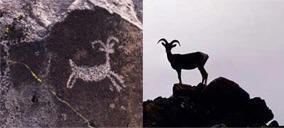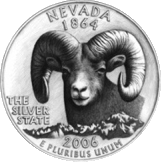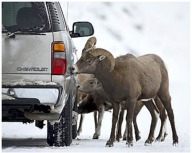Impact to Society
 In ancient times, like other
big game, bighorn sheep were a necessity to the survival of the human race. Native Americans such as the Nez
Pierce tribe in Hell's Canyon depended on bighorns, the meat for food, the hide
for clothing, and the horns for tools and bows. They realized the trade-off
required, balancing the populations to their own needs. However, when settlers
began invading
the territory they devastated, both directly and indirectly, the population of
bighorn sheep. They contaminated the water quality, overgrazed their farm
animals, and killed many more bighorns than were produced. It was not until the
1900s that concern had been realized. In 1905, Theodore Roosevelt was the first
to establish
National Forest Reserves to conserve many of the North American animals near
extinction. No matter how you look at it, throughout the years, humans have been the cause of bighorn
depletion. From the Westward Expansion to the diseases brought about by domestic
livestock, we ultimately
In ancient times, like other
big game, bighorn sheep were a necessity to the survival of the human race. Native Americans such as the Nez
Pierce tribe in Hell's Canyon depended on bighorns, the meat for food, the hide
for clothing, and the horns for tools and bows. They realized the trade-off
required, balancing the populations to their own needs. However, when settlers
began invading
the territory they devastated, both directly and indirectly, the population of
bighorn sheep. They contaminated the water quality, overgrazed their farm
animals, and killed many more bighorns than were produced. It was not until the
1900s that concern had been realized. In 1905, Theodore Roosevelt was the first
to establish
National Forest Reserves to conserve many of the North American animals near
extinction. No matter how you look at it, throughout the years, humans have been the cause of bighorn
depletion. From the Westward Expansion to the diseases brought about by domestic
livestock, we ultimately ![]() have an adverse affect on
the wildlife.
have an adverse affect on
the wildlife.
 Today,
bighorn sheep are protected by the federal government. They cannot be hunted
unless a special license is obtained from the DNR. These licenses are extremely
rare and only a few are issued each year. At North
Today,
bighorn sheep are protected by the federal government. They cannot be hunted
unless a special license is obtained from the DNR. These licenses are extremely
rare and only a few are issued each year. At North![]() Dakota's 2007 bighorn
sheep auction license, the highest bidder won the opportunity to hunt a bighorn.
Hunters are aware of this rare opportunity and are not going the pass it up.
Selling for a record $50,000, the North Dakota Game and Fish Department used the
money from the auction towards bighorn management. In 2007, only six licenses
for bighorn sheep were auctioned.
Dakota's 2007 bighorn
sheep auction license, the highest bidder won the opportunity to hunt a bighorn.
Hunters are aware of this rare opportunity and are not going the pass it up.
Selling for a record $50,000, the North Dakota Game and Fish Department used the
money from the auction towards bighorn management. In 2007, only six licenses
for bighorn sheep were auctioned.
![]()
Over the years of living amongst one another, bighorn sheep have become domesticated to humans. As seen in the picture to the right, a Rocky Mountain bighorn licks the snow off a vehicle. It is not uncommon to see bighorns standing alongside the roads of the Rocky Mountains, showing that the population of bighorns is recovering. Although the efforts today are making great strides towards bighorn conservation, there is still much work to be done.
